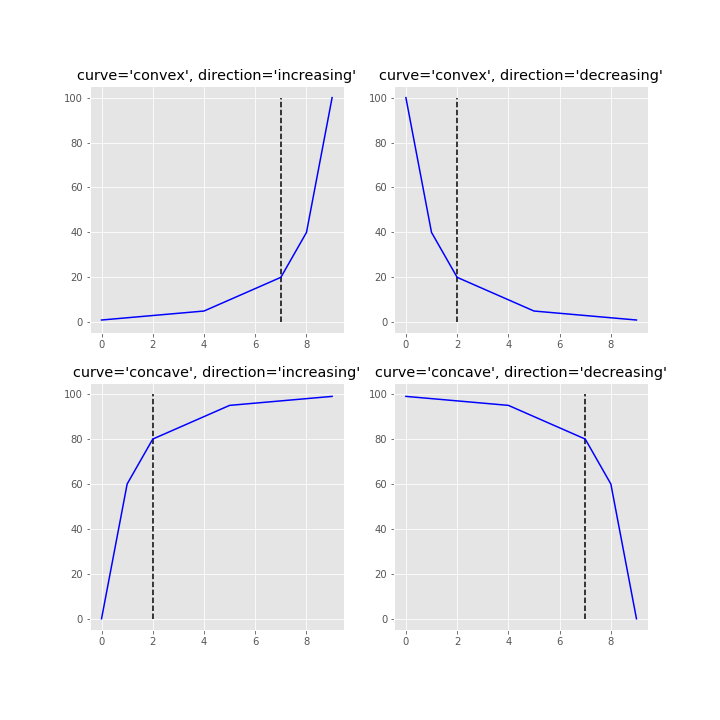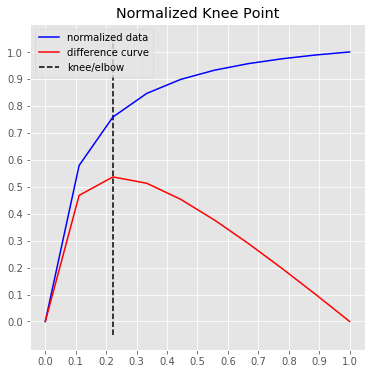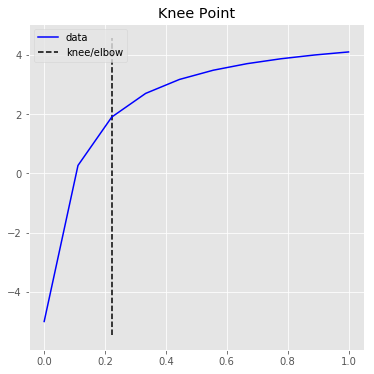kneed
Knee-point detection in Python







This repository is an attempt to implement the kneedle algorithm, published here. Given a set of x and y values, kneed will return the knee point of the function. The knee point is the point of maximum curvature.

Table of contents
Installation
kneed has been tested with Python 3.7, 3.8, 3.9, and 3.10.
anaconda
$ conda install -c conda-forge kneed
pip
$ pip install kneed
$ pip install kneed[plot]
Clone from GitHub
$ git clone https://github.com/arvkevi/kneed.git && cd kneed
$ pip install -e .
Usage
These steps introduce how to use kneed by reproducing Figure 2 from the manuscript.
Input Data
The DataGenerator class is only included as a utility to generate sample datasets.
Note: x and y must be equal length arrays.
from kneed import DataGenerator, KneeLocator
x, y = DataGenerator.figure2()
print([round(i, 3) for i in x])
print([round(i, 3) for i in y])
[0.0, 0.111, 0.222, 0.333, 0.444, 0.556, 0.667, 0.778, 0.889, 1.0]
[-5.0, 0.263, 1.897, 2.692, 3.163, 3.475, 3.696, 3.861, 3.989, 4.091]
Find Knee
The knee (or elbow) point is calculated simply by instantiating the KneeLocator class with x, y and the appropriate curve and direction.
Here, kneedle.knee and/or kneedle.elbow store the point of maximum curvature.
kneedle = KneeLocator(x, y, S=1.0, curve="concave", direction="increasing")
print(round(kneedle.knee, 3))
0.222
print(round(kneedle.elbow, 3))
0.222
The knee point returned is a value along the x axis. The y value at the knee can be identified:
print(round(kneedle.knee_y, 3))
1.897
Visualize
The KneeLocator class also has two plotting functions for quick visualizations.
Note that all (x, y) are transformed for the normalized plots
kneedle.plot_knee_normalized()

kneedle.plot_knee()

Documentation
Documentation of the parameters and a full API reference can be found here.
Interactive
An interactive streamlit app was developed to help users explore the effect of tuning the parameters.
There are two sites where you can test out kneed by copy-pasting your own data:
You can also run your own version -- head over to the source code for ikneed.

Contributing
Contributions are welcome, please refer to CONTRIBUTING
to learn more about how to contribute.
Citation
Finding a “Kneedle” in a Haystack:
Detecting Knee Points in System Behavior
Ville Satopa
†
, Jeannie Albrecht†
, David Irwin‡
, and Barath Raghavan§
†Williams College, Williamstown, MA
‡University of Massachusetts Amherst, Amherst, MA
§
International Computer Science Institute, Berkeley, CA








